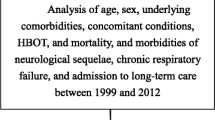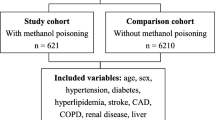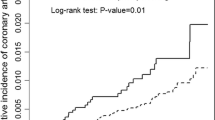Abstract
Carbon monoxide poisoning (COP) may lead to ischemic changes in organs, and heart is one of the most susceptible targets to ischemic condition. The objective of this study is to evaluate the risk of myocardial infarction following COP. Using a nationwide database of insurance claims in Taiwan, we conducted a population-based cohort study to identify COP patients diagnosed between 1999 and 2012. At a ratio of 3:1, we identified non-COP patients who were matched by the index date and age and compared the risk of myocardial infarction between the two cohorts by time after the index dates of the COP patients, until 2013. We identified 22,258 COP patients and 66,774 non-COP patients. COP patients had an increased risk of myocardial infarction, with an incidence rate ratio of 1.45 (95% confidence interval 1.06–1.98) in comparison with the non-COP patients after adjusting for other independent predictors, including older age, male sex, and underlying comorbidity of hypertension, diabetes, and renal disease. Stratified analyses showed that the increased risk was more prominent in patients with a young age (< 34 years), female sex, and liver disease, and occurred only in the first month of follow-up. We concluded that COP increased the risk of myocardial infarction, but the increased risk was only observed in the first month after COP, which indicated that the impact of COP on the heart was mainly acute. Patients who were younger than 34 years, female, and with liver diseases were more prone to myocardial infarction after COP.



Similar content being viewed by others
Abbreviations
- COP:
-
Carbon monoxide poisoning
- CO:
-
Carbon monoxide
- NPD:
-
Nationwide Poisoning Database
- LHID2000:
-
Longitudinal Health Insurance Database 2000
- CAD:
-
Coronary artery disease
- ICD-9:
-
International Classification of Diseases-9
- HIV:
-
Human immunodeficiency virus
- NTD:
-
New Taiwan Dollars
- IRR:
-
Incidence rate ratios
- CI:
-
Confidence interval
- AHR:
-
Adjusted hazard ratio
- HBOT:
-
Hyperbaric oxygen therapy
References
Weaver, L. K. (2009). Clinical practice. Carbon monoxide poisoning. New England Journal of Medicine 360, 1217–1225.
Hampson, N. B., & Weaver, L. K. (2007). Carbon monoxide poisoning: A new incidence for an old disease. Undersea & Hyperbaric Medicine, 34, 163–168.
Lee, F. Y., Chen, W. K., Lin, C. L., et al. (2015). Carbon monoxide poisoning and subsequent cardiovascular disease risk: A nationwide population-based cohort study. Medicine (Baltimore), 94, e624.
Pan, Y. J., Liao, S. C., & Lee, M. B. (2010). Suicide by charcoal burning in Taiwan, 1995–2006. Journal of Affective Disorders, 120, 254–257.
Lee, D. T., Chan, K. P., Lee, S., et al. (2002). Burning charcoal: A novel and contagious method of suicide in Asia. Archives of General Psychiatry, 59, 293–294.
Ernst, A., & Zibrak, J. D. (1998). Carbon monoxide poisoning. New England Journal of Medicine, 339, 1603–1608.
Zou, J. F., Guo, Q., Shao, H., et al. (2015). Lack of pupil reflex and loss of consciousness predict 30-day neurological sequelae in patients with carbon monoxide poisoning. PLoS ONE, 10, e0119126.
Zou, J. F., Guo, Q., Shao, H., et al. (2014). A positive Babinski reflex predicts delayed neuropsychiatric sequelae in Chinese patients with carbon monoxide poisoning. BioMed Research International, 2014, 814736.
Kalay, N., Ozdogru, I., Cetinkaya, Y., et al. (2007). Cardiovascular effects of carbon monoxide poisoning. The American Journal of Cardiology, 99, 322–324.
Satran, D., Henry, C. R., Adkinson, C., et al. (2005). Cardiovascular manifestations of moderate to severe carbon monoxide poisoning. Journal of the American College of Cardiology, 45, 1513–1516.
Hampson, N. B., Piantadosi, C. A., Thom, S. R., et al. (2012). Practice recommendations in the diagnosis, management, and prevention of carbon monoxide poisoning. American Journal of Respiratory and Critical Care Medicine, 186, 1095–1101.
Brown, S. D., & Piantadosi, C. A. (1989). Reversal of carbon monoxide–cytochrome c oxidase binding by hyperbaric oxygen in vivo. Advances in Experimental Medicine and Biology, 248, 747–754.
Brown, S. D., & Piantadosi, C. A. (1990). In vivo binding of carbon monoxide to cytochrome c oxidase in rat brain. Journal of Applied Physiology, 68, 604–610.
Brown, S. D., & Piantadosi, C. A. (1992). Recovery of energy metabolism in rat brain after carbon monoxide hypoxia. Journal of Clinical Investigation, 89, 666–672.
Piantadosi, C. A., Zhang, J., Levin, E. D., et al. (1997). Apoptosis and delayed neuronal damage after carbon monoxide poisoning in the rat. Experimental Neurology, 147, 103–114.
Thom, S. R. (1990). Antagonism of carbon monoxide–mediated brain lipid peroxidation by hyperbaric oxygen. Toxicology and Applied Pharmacology, 105, 340–344.
Thom, S. R., Bhopale, V. M., Fisher, D., et al. (2004). Delayed neuropathology after carbon monoxide poisoning is immune-mediated. Proceedings of the National Academy of Sciences of the USA, 101, 13660–13665.
Thom, S. R., Bhopale, V. M., & Fisher, D. (2006). Hyperbaric oxygen reduces delayed immune-mediated neuropathology in experimental carbon monoxide toxicity. Toxicology and Applied Pharmacology, 213, 152–159.
Thom, S. R., Bhopale, V. M., Han, S. T., et al. (2006). Intravascular neutrophil activation due to carbon monoxide poisoning. American Journal of Respiratory and Critical Care Medicine, 74, 1239–1248.
Thom, S. R. (2008). Carbon monoxide pathophysiology and treatment. In T. S. Neuman & S. R. Thom (Eds.), Physiology and medicine of hyperbaric oxygen therapy (pp. 321–347). Philadelphia: Saunders Elsevier.
Thom, S. R., Bhopale, V. M., Milovanova, T. M., et al. (2010). Plasma biomarkers in carbon monoxide poisoning. Clinical Toxicology (Philadelphia), 48, 47–56.
National Health Insurance Administration, Ministry of Health and Welfare, Taiwan, R.O.C. (2014). National Health Insurance Annual Report 2014–2015.
Henry, C. R., Satran, D., Lindgren, B., et al. (2006). Myocardial injury and long-term mortality following moderate to severe carbon monoxide poisoning. JAMA, 295, 398–402.
Tritapepe, L., Macchiarelli, G., Rocco, M., et al. (1998). Functional and ultrastructural evidence of myocardial stunning after acute carbon monoxide poisoning. Critical Care Medicine, 26, 797–801.
Dziewierz, A., Ciszowski, K., Gawlikowski, T., et al. (2013). Primary angioplasty in patient with ST-segment elevation myocardial infarction in the setting of intentional carbon monoxide poisoning. The Journal of Emergency Medicine, 45, 831–834.
Sward, D. G., Sethuraman, K. N., Wong, J. S., et al. (2016). Carbon monoxide and ST-elevation myocardial infarction: case reports. Undersea & Hyperbaric Medicine, 43, 63–69.
Unlu, M., Ozturk, C., Demirkol, S., et al. (2016). Thrombolytic therapy in a patient with inferolateral myocardial infarction after carbon monoxide poisoning. Human & Experimental Toxicology, 35, 101–105.
Mustafic, H., Jabre, P., Caussin, C., et al. (2012). Main air pollutants and myocardial infarction: A systematic review and meta-analysis. JAMA, 307, 713–721.
Huang, C. C., Chung, M. H., Weng, S. F., et al. (2014). Long-term prognosis of patients with carbon monoxide poisoning: A nationwide cohort study. PLoS ONE, 9, e105503.
Jónsdóttir, L. S., Sigfússon, N., Gudnason, V., et al. (2002). Do lipids, blood pressure, diabetes, and smoking confer equal risk of myocardial infarction in women as in men? The Reykjavik Study. Journal of Cardiovascular Risk, 9, 67–76.
Anand, S. S., Islam, S., Rosengren, A., et al. (2008). Risk factors for myocardial infarction in women and men: Insights from the INTERHEART study. European Heart Journal, 29, 932–940.
Prescott, E., Hippe, M., Schnohr, P., et al. (1998). Smoking and risk of myocardial infarction in women and men: Longitudinal population study. BMJ, 316, 1043–1047.
Sarnak, M. J., Levey, A. S., Schoolwerth, A. C., et al. (2003). Kidney disease as a risk factor for development of cardiovascular disease: a statement from the American Heart Association Councils on kidney in cardiovascular disease, high blood pressure research, clinical cardiology, and epidemiology and prevention. Circulation, 108, 2154–2169.
Allred, E. N., Bleecker, E. R., Chaitman, B. R., et al. (1989). Short-term effects of carbon monoxide exposure on the exercise performance of subjects with coronary artery disease. New England Journal of Medicine, 321, 1426–1432.
Kleinman, M. T., Davidson, D. M., Vandagriff, R. B., et al. (1989). Effects of short-term exposure to carbon monoxide in subjects with coronary artery disease. Archives of Environmental Health, 44, 361–369.
von Klot, S., Peters, A., Aalto, P., et al. (2005). Ambient air pollution is associated with increased risk of hospital cardiac readmissions of myocardial infarction survivors in five European cities. Circulation, 112, 3073–3079.
Bell, M. L., Peng, R. D., Dominici, F., et al. (2009). Emergency hospital admissions for cardiovascular diseases and ambient levels of carbon monoxide: Results for 126 United States urban counties, 1999–2005. Circulation, 120, 949–955.
Nawrot, T. S., Perez, L., Künzli, N., Munters, E., & Nemery, B. (2011). Public health importance of triggers of myocardial infarction: A comparative risk assessment. Lancet, 377, 732–740.
Yücel, M., Avsarogullari, L., Durukan, P., et al. (2016). BNP shows myocardial injury earlier than Troponin-I in experimental carbon monoxide poisoning. European Review for Medical and Pharmacological Sciences, 20, 1149–1154.
Szponar, J., Kołodziej, M., Majewska, M., et al. (2012). Myocardial injury in the course of carbon monoxide poisoning. Przegl Lek, 69, 528–534.
Lippi, G., Rastelli, G., Meschi, T., et al. (2012). Pathophysiology, clinics, diagnosis and treatment of heart involvement in carbon monoxide poisoning. Clinical Biochemistry, 45, 1278–1285.
Garg, J., Krishnamoorthy, P., Palaniswamy, C., et al. (2014). Cardiovascular abnormalities in carbon monoxide poisoning. American Journal of Therapeutics. https://doi.org/10.1097/MJT.0000000000000016.
Cheng, C. L., Lee, C. H., Chen, P. S., et al. (2014). Validation of acute myocardial infarction cases in the national health insurance research database in taiwan. Journal of Epidemiology, 24, 500–507.
Health Promotion Adminstration, Ministry of Health and Welfare, Taiwan. Health indicators 123. Retrieved from https://olap.hpa.gov.tw/en_US/Index.aspx?menu=-1&vid=1.
Funding
This study was supported by Grants CMFHR10677 and CMFHR10734 from the Chi-Mei Medical Center.
Author information
Authors and Affiliations
Contributions
C-C Huang and H-RG designed and conceived this study and wrote the manuscript. H-CH and Y-CC performed the statistical analysis and wrote the manuscript. H-JL, C-C Hsu, J-JW, and S-BS provided professional suggestions and wrote the manuscript. All the authors have read and approved the final manuscript.
Corresponding author
Ethics declarations
Conflict of interest
The authors declare no potential conflicts of interest.
Ethical Approval
This study involved human data and was conducted in strict accordance with the Declaration of Helsinki. The study protocol was approved by the Institutional Review Board (IRB) at the Chi-Mei Medical Center.
Informed Consent
The two databases consisted of depersonalized information, and so the requirement of informed consent was waived by the IRB as the study did not affect the welfare of the participants.
Additional information
Handling Editor: Gen Suzuki.
Rights and permissions
About this article
Cite this article
Huang, CC., Ho, CH., Chen, YC. et al. Risk of Myocardial Infarction After Carbon Monoxide Poisoning: A Nationwide Population-Based Cohort Study. Cardiovasc Toxicol 19, 147–155 (2019). https://doi.org/10.1007/s12012-018-9484-9
Published:
Issue Date:
DOI: https://doi.org/10.1007/s12012-018-9484-9




